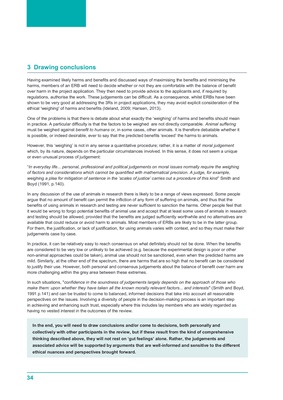
34
3 Drawing conclusions
Having examined likely harms and benefits and discussed ways of maximising the benefits and minimising the
harms, members of an ERB will need to decide whether or not they are comfortable with the balance of benefit
over harm in the project application. They then need to provide advice to the applicants and, if required by
regulations, authorise the work. These judgements can be difficult. As a consequence, whilst ERBs have been
shown to be very good at addressing the 3Rs in project applications, they may avoid explicit consideration of the
ethical 'weighing' of harms and benefits (Ideland, 2009; Hansen, 2013).
One of the problems is that there is debate about what exactly the "weighing" of harms and benefits should mean
in practice. A particular difficulty is that the factors to be weighed are not directly comparable. Animal suffering
must be weighed against benefit to humans or, in some cases, other animals. It is therefore debatable whether it
is possible, or indeed desirable, ever to say that the predicted benefits "exceed" the harms to animals.
However, this "weighing" is not in any sense a quantitative procedure; rather, it is a matter of moral judgement
which, by its nature, depends on the particular circumstances involved. In this sense, it does not seem a unique
or even unusual process of judgement:
"In everyday life... personal, professional and political judgements on moral issues normally require the weighing
of factors and considerations which cannot be quantified with mathematical precision. A judge, for example,
weighing a plea for mitigation of sentence in the "scales of justice" carries out a procedure of this kind" Smith and
Boyd (1991, p.140).
In any discussion of the use of animals in research there is likely to be a range of views expressed. Some people
argue that no amount of benefit can permit the infliction of any form of suffering on animals, and thus that the
benefits of using animals in research and testing are never sufficient to sanction the harms. Other people feel that
it would be wrong to forgo potential benefits of animal use and accept that at least some uses of animals in research
and testing should be allowed, provided that the benefits are judged sufficiently worthwhile and no alternatives are
available that could reduce or avoid harm to animals. Most members of ERBs are likely to be in the latter group.
For them, the justification, or lack of justification, for using animals varies with context, and so they must make their
judgements case by case.
In practice, it can be relatively easy to reach consensus on what definitely should not be done. When the benefits
are considered to be very low or unlikely to be achieved (e.g. because the experimental design is poor or other
non-animal approaches could be taken), animal use should not be sanctioned, even when the predicted harms are
mild. Similarly, at the other end of the spectrum, there are harms that are so high that no benefit can be considered
to justify their use. However, both personal and consensus judgements about the balance of benefit over harm are
more challenging within the grey area between these extremes.
In such situations, "confidence in the soundness of judgements largely depends on the approach of those who
make them: upon whether they have taken all the known morally relevant factors... and interests" (Smith and Boyd,
1991 p.141) and can be trusted to come to balanced, informed decisions that take into account all reasonable
perspectives on the issues. Involving a diversity of people in the decision-making process is an important step
in achieving and enhancing such trust, especially where this includes lay members who are widely regarded as
having no vested interest in the outcomes of the review.
In the end, you will need to draw conclusions and/or come to decisions, both personally and
collectively with other participants in the review, but if these result from the kind of comprehensive
thinking described above, they will not rest on "gut feelings" alone. Rather, the judgements and
associated advice will be supported by arguments that are well-informed and sensitive to the different
ethical nuances and perspectives brought forward.